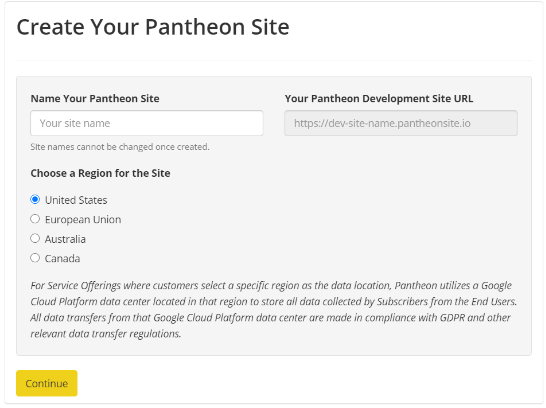Pantheon is a professional website platform designed for web teams who are in charge of creating WordPress and Drupal sites. The platform is designed for WebOps, with features that facilitate collaboration and automate processes to improve productivity and empower the whole web team to develop, test, and release website changes faster and more reliably.
Pantheon is a great choice for WordPress Hosting, WordPress Enterprise, WordPress Developers, and WordPress Multisite.
The platform powers more than 300,000 websites. Pantheon’s customers include Google, The Home Depot, Harvard University, and many more.
Getting Started
If you’re not sure if Pantheon is perfect for you, you can try it out by signing up for a free account, which will give you two free Sandbox sites. You can spin up a working WordPress installation on one of your free dev environments and tinker with it in any way you like.
For a more detailed information on how to get started, you can read the Pantheon tutorial, “Creating Sites.”
And when you’re ready to take your site live, you only need to pay for that one. You can even invite and add your clients to join and let them pay for the project’s monthly or annual subscription plan.
Pricing for each Pantheon Plan depends mainly on the amount of pageviews that your site is going to get. It’s as low as $29 per month for the basic plan (up to 125,000 pageviews) and as high as $687 per month for 1.5 million pageviews. For sites that go over that, you’ll have to contact Pantheon to discuss pricing.
“We know we’re expensive than a lot of WordPress hosting, but we think our service offers a lot more value, and hopefully clients and customers should be able to see that too. If we save one developer hour a month, it should more than pay for itself”
- Josh Koenig, Pantheon co-founder and Head of Product.
Is Pantheon out of your budget? Try a budget-friendly web hosting service with Network Solutions.
Understanding How Pantheon Works
Pantheon gives you the best set of professional web development tools that lets you focus on developing WordPress sites and deliver more value to your clients -- and without worrying about the infrastructure, traffic spikes, security, or web performance.
Pantheon’s WebOps framework automates many time-consuming development tasks, so the web team can focus on making iterative, incremental improvements to the website. This eliminates the need for costly, time-consuming relaunches, and makes the team more agile.
Each Pantheon development environment includes a dashboard that is equipped with these power tools:
Continuous integration workflow
Git and SFTP Mode
One-click deployment (on the same platform you used to build it)
Separate Dev, Test, and Live environments
One-click core updates
Add-ons like Apache Solr and Redis
Automated backups
Automated WordPress updates
In your Pantheon Dashboard, you will find the Dev, Test, and Live environments. These separate workspaces allow you to develop and test your site without impacting the live site.
For more detailed information, you can read about the Pantheon WebOps Workflow. You may notice that some of Pantheon’s tutorials have Drupal as examples but there’s no need to worry as the Pantheon workflow is the same for both CMS platforms.
Importing a WordPress Site into Pantheon
Any developer knows that moving a WordPress site to another server is a fragile process. However, in Pantheon you only need to do two things: first, use WordPress Duplicator for archiving, and second, let Pantheon import the archive for you.
Alternatively, if you’re comfortable in the command line and have ssh access to your old WordPress server, you can use mysqldump to export the database and zip everything up into a single archive.
Once you have the archive file, store it in a place where you can retrieve it via a URL. You will only need to copy and paste the URL to import everything to Pantheon.
For a complete and detailed tutorial on how to import a WordPress site, read the Pantheon article, “Migrate Sites to Pantheon.”
Scaling with Pantheon
Your WordPress site on Pantheon is capable of scaling hundreds of millions of pageviews on day one. You won’t need to upgrade to VMs and server clusters
.
To help websites scale, Pantheon uses a method called “containerization,” in which Pantheon simply adjusts the number of containers that are running. Containers take sites from hundreds of pageviews to hundreds of millions of pageviews without any downtime or architectural changes, to make scaling up more affordable and granular.
Equipped with the world’s first container-based infrastructure for professional WordPress websites, Pantheon handles massive pageviews like a drop in the bucket.
Getting Customer Support
Existing Pantheon users can attest that customer service from the Pantheon team is top notch. I can personally vouch for that as I am able to talk with the founders themselves.
Jason Schaffer, CEO of Blue Coda, says,
“Not only do we get a lightning-fast response, but we get actual help and resolution.”
Partnering with Pantheon
If you own or are part of a website development shop or agency, Pantheon offers a Partner Program for you. Benefits include preferred pricing; inclusion in the partner directory; live training through Pantheon Academy; and free Pantheon hosting for company and personal websites.
What Developers Are Saying About Pantheon on WordPress
“Customer support has been absolutely superior to other hosting options/VPS providers/Datacenters. Uptime is as advertised, specifically-tuned environments for Drupal and Wordpress perform flawlessly; UI is simple, intuitive and easy to use.”
- Christopher H., Development Team Manager
“The dashboard is very intuitive, providing site owners and admins complete control over development, testing and deployment. The dedicated environments for each phase are phenomenal! Support docs are also very complete and comprehensive.”
- Joshua P., Senior Web Developer





